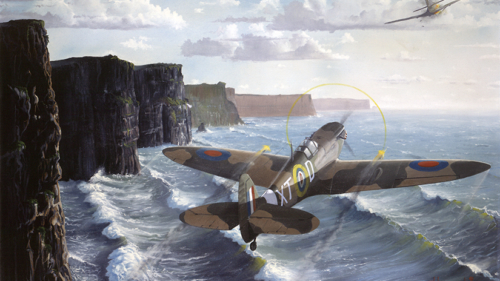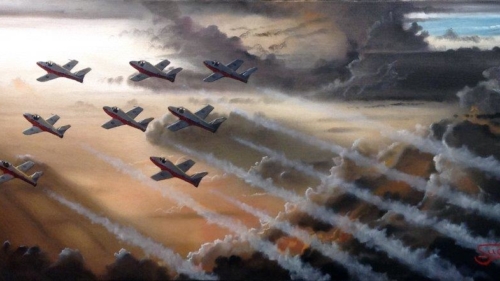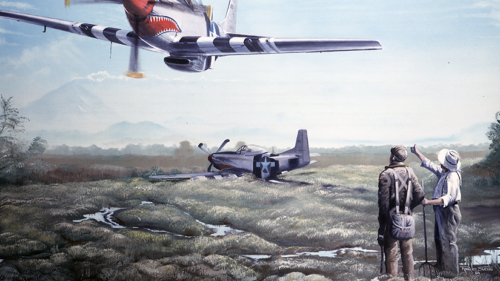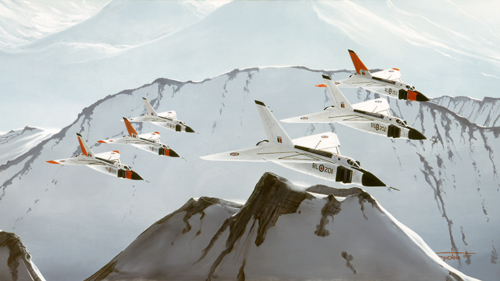ENTERING THE LABYRINTH
Signed by Don Rogers & Reg Lane
CAD $145 – CAD $600
“ENTERING THE LABYRINTH”
This painting of two Lancasters is entitled “Entering The Labyrinth” for a very specific reason. It is common for artists to portray their subjects in a manner that allows you to readily envision what has just happened or is presently happening in the art piece. In depicting the two aircraft making a very obvious flight alteration and showing them in a pose that allows the viewer to see only where they have been, I feel the piece will insist that you are the one that has to make up the rest of the story. Therefore, you are allowed the privilege, if I may be so bold, of being part of the creative force that will drive the effect of the image itself a little further than normal. So go for it, I’ve started the story, now you finish it! -Ronald Suchiu
Counter Signed
The pilots that flew these two planes have personally countersigned all printer proofs, artist proofs, and numbered prints. They are Lt. General R J Lane and the very interesting Don Rogers.

If you are familiar with the Avro Arrow you may recognize the name Don Rogers. He was very involved with that famous piece of history and as some added information he was also hired by the late Howard Hughes as the test pilot for some of his planes.

The upper image is that of Lancaster FM 212, one of 430 Lancaster bombers to be built in Canada during World War II. As this particular aircraft was completed towards the end of the war, it was converted to photo-mapping duties and is shown in that configuration. Lancaster FM 212 flew 8,100 hours, mapping Canada’s northern regions. It first served with 413 Squadron but spent most of its time as part of 408 Squadron. Retired in 1962, it was placed in Jackson Park, at Windsor, Canada in 1965
The lower image is that of “The Ruhr Express”, built-in 1943, it was the very first Lancaster bomber from Canada to go to war. Its construction demonstrated to skeptics that Canada was capable of such wartime production. It is shown flying in its wartime configuration. Plans were made to retire this first Canadian Lancaster after completing 50 missions and returning it to Canada for proud display. Unfortunately, the Ruhr Express sustained extensive damage that caused a bad landing when completing its 49th mission. The entire crew managed to escape, but the aircraft was totally destroyed by fire. The Ruhr Express first served with the Pathfinder Force 405 Squadron, later with 419 Squadron.

LANCASTER HISTORY

Roy Chadwick
CBE MSc FRSA FRAES
1893 – 1947
Roy Chadwick, the designer of the AVRO Lancaster, who has been described as ‘one’ of the two or three top designers of this century, was born in England, at Farnworth near Widnes, Lancashire.
He was the fifth generation of engineers in his father’s family. When he was fourteen, Roy Chadwick entered the British Westinghouse Drawing office in 1907; he also began studying at the Manchester College of Technology, at night, after work.
In 1909, Alliot Verdon-Roe, England’s pioneer airplane constructor and aviator opened his own company, A.V. Roe & Company Ltd. As his apprenticeship drew to a close at Westinghouse in December 1911, Roy Chadwick joined the firm, and A.V. Roe engaged him as his personal assistant. All the 500 AVRO series of airplanes, including the AVRO 504 of W.W.I passed through his hands, in the design stage.
Roy Chadwick soon became head of the design team and Chief Designer in 1918. He designed the Pike, the W.W.I Manchester, and the giant Aldershot, the world’s biggest single-engine bomber. Many variants of the plane followed. Also, many civil and military aircraft flowed from his drawing board. He designed the world’s first true light aircraft, the AVRO Baby, in 1919.
The 1920s and early 1930s saw Chadwick design such airplanes as the AVR Avian and Tutor. The Tutor was a trainer used by the Royal Air Force to train pilots for WWII.
In 1933 the AVRO 18, a welded steel tube, fabric-covered 16-seat plane, was soon converted for the RAF into the AVRO Anson, a light bomber and transport plane. Over 7000 were built. Many bomber crews were trained on Ansons in Canada.
Roy Chadwick received an Air Ministry specification in 1937 for a long-range, all-metal bomber of advanced conception, powered by two Rolls Royce Vulture engines. Chadwick’s intuitive, forward-thinking ensured that a huge bomb bay, capable of holding ten tons of bombs and mines, in any combination, was part of the design. Also, that the fuselage was made in five separate sections, for manufacture at different factories and for ease of assembly at Woodford, AVRO’s giant assembly works in Cheshire. The machine was named the Manchester, and the prototype L7246 made its initial flight in July 1939, with squadron #207 receiving Manchesters in November 1940.
Immediately, it was obvious that the Vulture engines were inadequate, and Roy Chadwick, who had always wanted the Rolls Royce Merlin engines, and who had designed a four-engine version of the Manchester, showed the Air Ministry how he could lengthen the Manchester wing and install four Merlin engines. This was agreed upon, and the Lancaster was born.
The conversion was carried out between November 1940 and January 1941, and right away it was evident that the Lancaster was a highly successful airplane. Production followed rapidly, and AVRO had seven factories and 100 sub-contractors building Lancasters, thus employing 40, 000 persons. In the RAF, 35 squadrons were equipped with Lancasters, which could fly higher and penetrate deeper into enemy territory than any other contemporary machine and which could carry the heaviest loads.
There were over 200 draughtsmen and tracers in Roy Chadwick’s drawing office. Every week, he would go around the office and look at the work of each draughtsman. He could spot a mistake immediately and correct it. During the war, he designed far into the night on the myriad modifications incorporated into the Lancaster for various operations, including the Dam Buster raid in 1943.
Other aircraft designed by Chadwick include the Shackleton, York, Tudor, and Lincoln. He had left, in the hands of the Air Ministry, his last brilliant conception: the giant Delta Wing Bomber, the Vulcan, a front line RAF plane, for over thirty years.
In 1944, Manchester University made him an Honorary Master of Science, and the College made him an Associate in 1946.
Roy Chadwick met his untimely death on Saturday, August 23 1947 on a test flight of the AVRO Tudor II. An overnight servicing error resulted in the aircraft losing control and crashing soon after takeoff.
Roy Chadwick lived and died for aviation. His influence lives on in Delta design. His greatest hope was that the airplane would unite the people of the world.
Written by, Margaret Dove, Daughter of Roy Chadwick 1996







